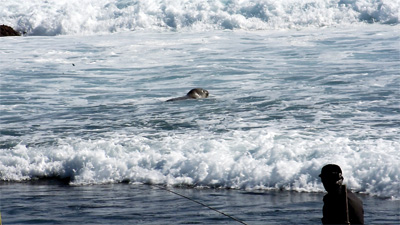News
Lost elephant seal pup closely guarded on unique visit
A young southern elephant seal – the largest of all seals – was spotted by amazed witnesses near Unawatuna this week, the first time an elephant seal has been spotted in the northern Indian Ocean.

A still from a video grab showing the southern elephant seal spotted in Unawatuna
Southern elephant males can be more than 7m (20 feet) long and weigh almost 4,000kg. These massive creatures take their name from their trunk-like inflatable snouts with which they produce loud roars, especially during the breeding season.
Fishermen and other visitors who spotted the young elephant seal on a beach near Unawatuna on November 20 were baffled by the sight, wondering if it was a seal or a sealion but knowing that both those species live in much cooler climates.
Video footage was widely shared, and after studying the videos, marine mammal specialist Dr. Asha de Vos recognised the visitor to be a juvenile southern elephant seal (Mirounga leonine). Pups of this species are born with fur and are completely black.
Southern elephant seals live in sub-Antarctic and Antarctic waters that feature extremely cold conditions but are rich in fish, squid, and other marine foods, according to the magazine, National Geographic.
Experts said this was the first record of such a seal being seen in the northern Indian Ocean.
After being notified by villagers, the Department of Wildlife Conservation’s (DWC)’s Hikkaduwa unit rushed to the beach to take care of the creature.
“We reached the beach around 10am and made sure the animal was safe. The seal was about 6 feet (1.8m) long and its behavior suggested it wanted to come to the beach to rest,” Ranger Uthpala Adaranga said.
The navy and police also helped ensure the unusual visitor’s safety and it was there on the beach until nightfall, Mr. Adaranga said. “The next day, it was gone, and we hope it will find its path,” the ranger added hopefully.
A scientist at the National Aquatic Resources Research and Development Agency (NARA), Upul Liyanage, who was present in the scene, said the seal could have been dragged off its course and towards Sri Lankan by an oceanic current linked to the north-east monsoon.
Dr. de Vos said vagrant southern elephant seals had been recorded in unusual places. “We do not know why this happened this time but it is important that the seal be given space to rest if it is found again,” she urged.
As global warming causes polar ice sheets to shrink, seals that depend on the ice for resting, mating and giving birth are having their mating cycles disrupted, scientists said.
The warming is also damaging the food web affecting algae, krill and plankton in polar regions where seals live. As food availability decreases, seals and other creatures might have to move further from their native grounds, which makes them vulnerable to harm.

